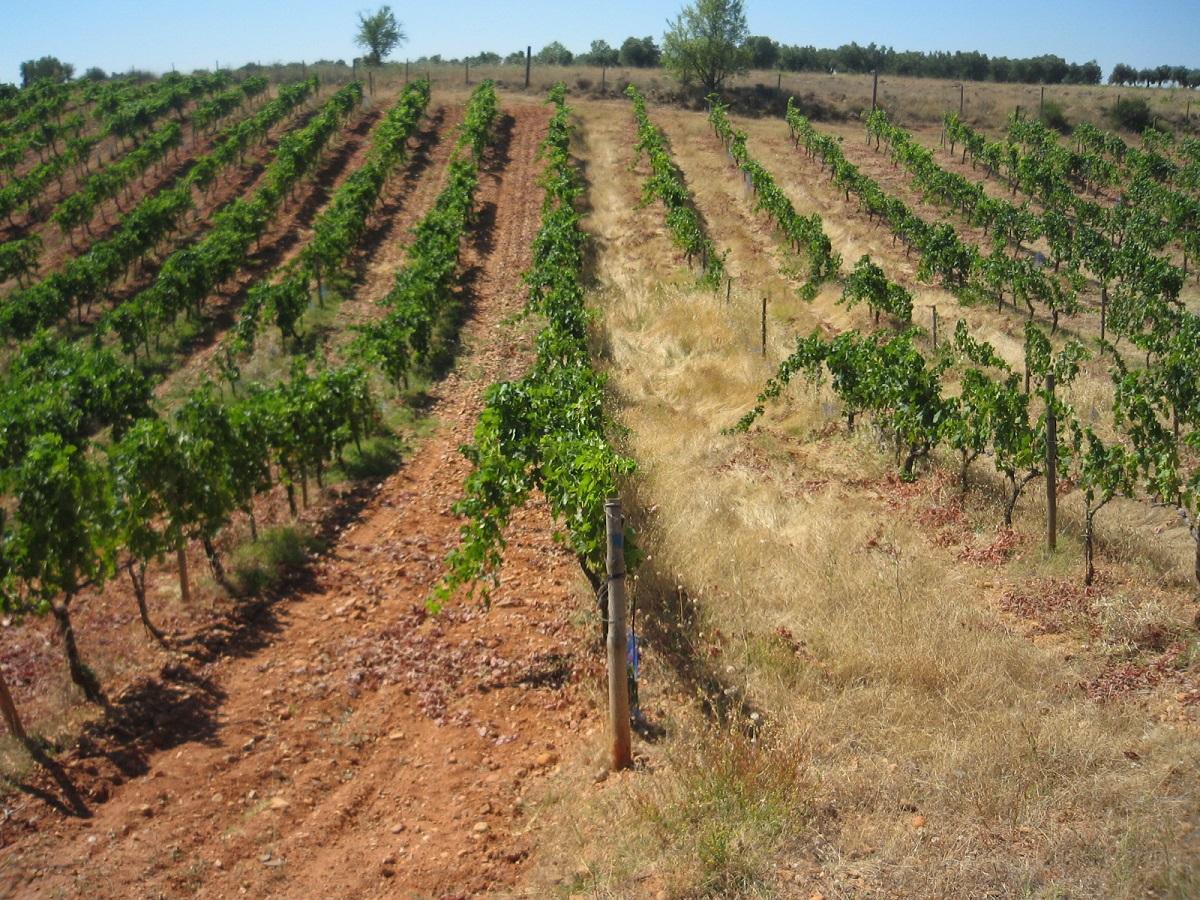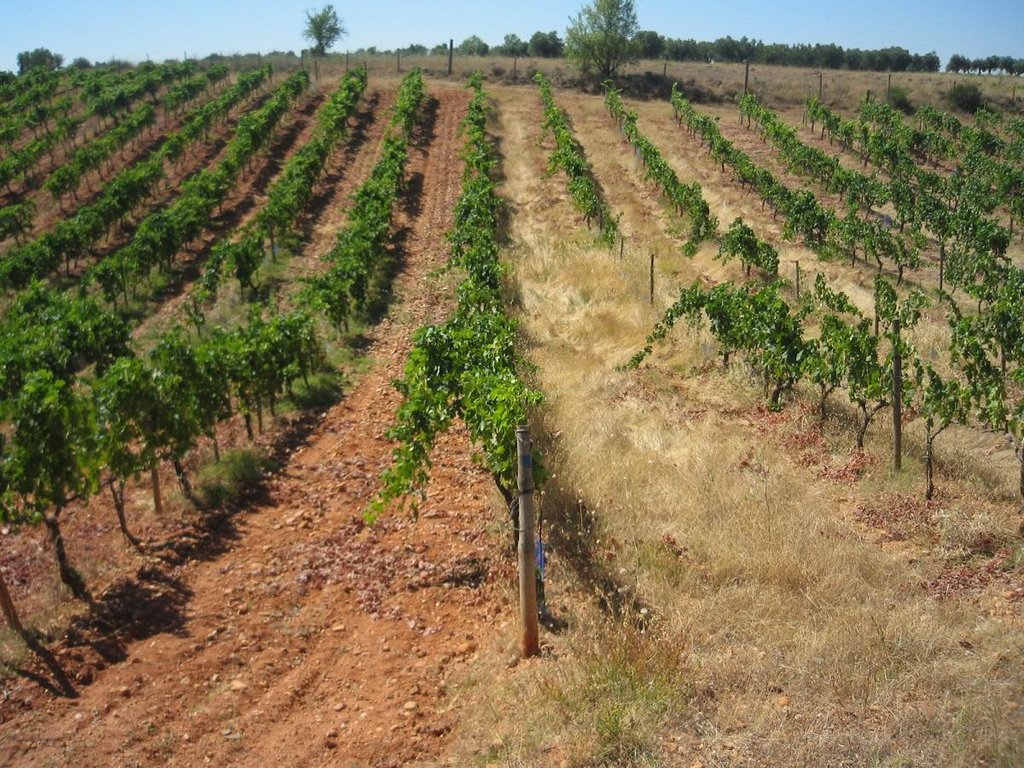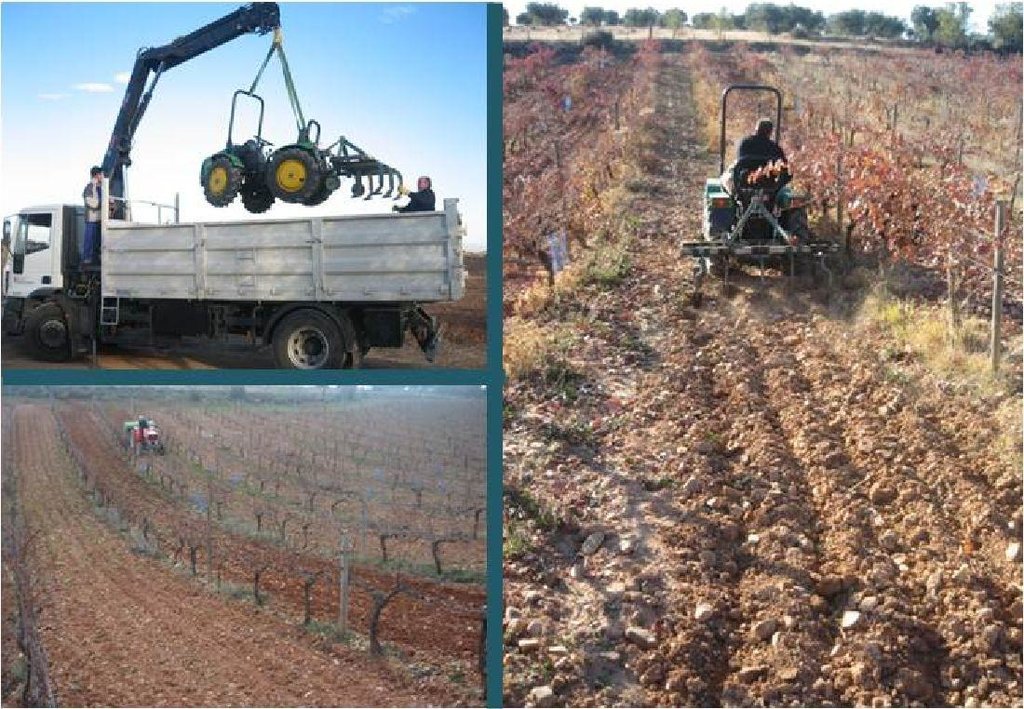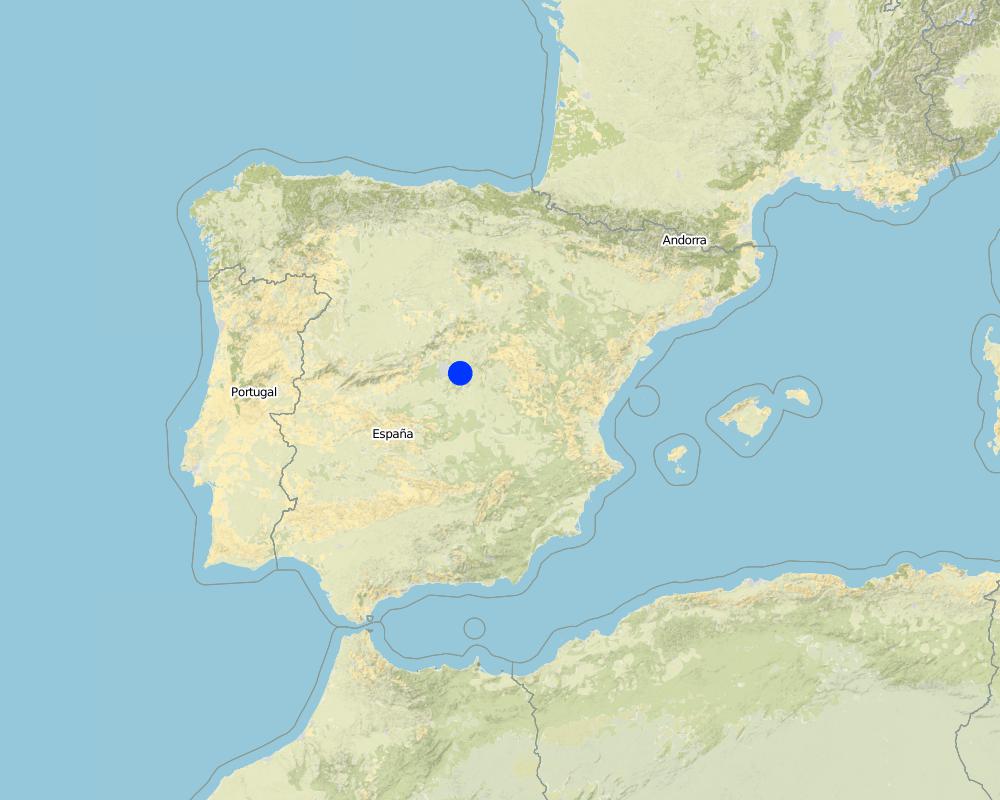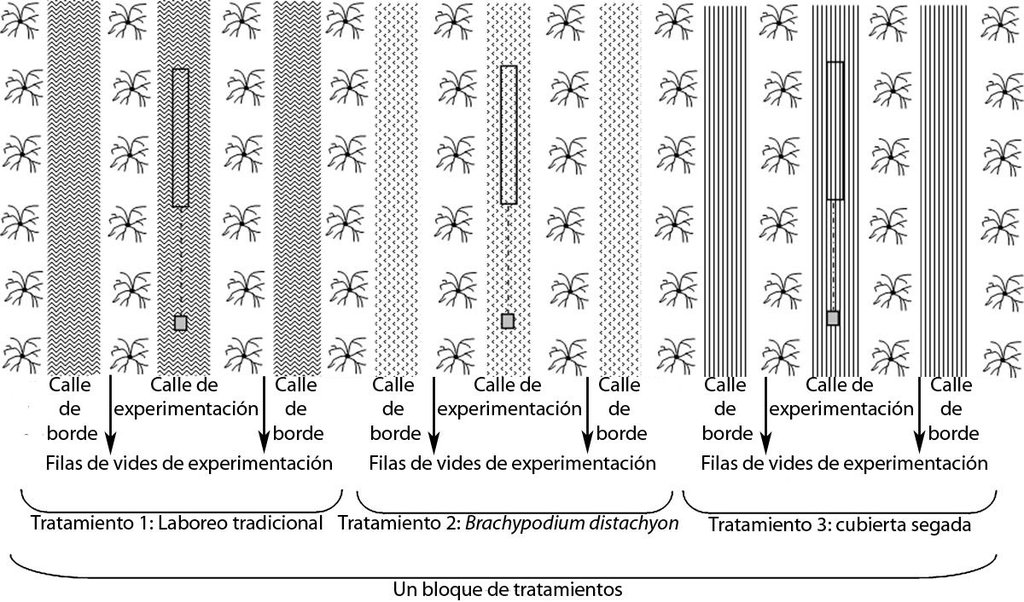Cover crops in organic vineyard [Espanha]
- Criação:
- Atualização:
- Compilador/a: CELIA BARBERO SIERRA
- Editor: –
- Revisores: Fabian Ottiger, Alexandra Gavilano
Cubiertas vegetales en calles de viñedos
technologies_1162 - Espanha
Veja as seções
Expandir tudo Recolher tudo1. Informação geral
1.2 Detalhes do contato das pessoas capacitadas e instituições envolvidas na avaliação e documentação da tecnologia
Especialista em GST:
Especialista em GST:
Ruíz Colmenero Marta
Instituto Madrileño de Investigación y Desarrollo Rural, Agrario y Alimentario - IMIDRA
Espanha
Especialista em GST:
Bienes Ramon
Instituto Madrileño de Investigación y Desarrollo Rural, Agrario y Alimentario - IMIDRA
Nome da(s) instituição(ões) que facilitou(ram) a documentação/ avaliação da Tecnologia (se relevante)
UNIVERSIDAD AUTONOMA DE MADRID (UNIVERSIDAD AUTONOMA DE MADRID) - EspanhaNome da(s) instituição(ões) que facilitou(ram) a documentação/ avaliação da Tecnologia (se relevante)
IMIDRA (IMIDRA) - Espanha1.3 Condições em relação ao uso da informação documentada através de WOCAT
O/a compilador/a e a(s) pessoa(s) capacitada(s) aceitam as condições relativas ao uso de dados documentados através da WOCAT:
Sim
2. Descrição da tecnologia de GST
2.1 Descrição curta da tecnologia
Definição da tecnologia:
Use of cover crops to prevent erosion and increase soil organic matter.
2.2 Descrição detalhada da tecnologia
Descrição:
In total there were 66 rows of vineyards of the Tempranillo red variety, spaced 3 m apart with a distance of 2.5 m between vines. To date they have been worked using conventional tilling without herbicides: most of the work is done mainly in the winter, followed by two or three sessions in spring aimed at controlling the growth of weeds, which is conditioned by the spring rains.
The technology is based on minimum tillage and the use of Secale cereale L and Brachypodium distachyon (L.) as cover crops to protect the soil against erosion and to increase the organic matter.
Purpose of the Technology: The main purposes of this technology are to fight against erosion and water runoff and to increase soil organic matter.
Indirectly this technology contributes to increase biodiversity in the vineyards and it could have some positive effects on wine quality (related to the content of sugar and poliphenoles) as proved by some authors (Dry et al., 2001).
Cover crops usually increase the soil moisture but on the other hand, along the summer, the cover crops and the vines are in competition for the scarce water available in the area.
Establishment / maintenance activities and inputs: The plant cover in the centre of the rows was sown in mid-November, following the copious rains in the autumn of 2006. A minimum tillage (15cm depth) is carried out before sowing. The seeding rates were 70 kg/ha for rye, Secale cereale L., and 40 kg/ha for purple false brome, Brachypodium distachyon (L.) P. Beauv. This latter cover had to be reseeded by hand since the seeds have to be buried at a very low depth. It sprouts in late winter or early spring and by late June it is already mature and dry, at which point it self-sows and it sprouts spontaneously again the following autumn. The Secale cover has to be cut in spring and re-sown in late autumn.
Once sown, the resulting vineyard was divided into alternating rows with three treatments: bare soil with traditional tilling, rows covered with Secale and rows covered with Brachypodium.
The maintenance activities consist of no tillage in winter and conservation of natural cover crops until spring.
Natural / human environment: The area is at an altitude of 800 m, in a semiarid Mediterranean climate where the recorded annual rainfall is below 400 mm and the average annual temperature is 14 ºC, with very hot and occasionally stormy summers and very cold winters. It rains primarily in spring and autumn.
The farmland is predominantly dry, especially where olives and vines are planted. Oaks (holm, Portuguese and hermes) can be found in nearby wild areas and in abandoned terrains. The study focused on the area of Campo Real in the southeast of Madrid, in the centre of Spain. The vineyard covers an area of some 2 ha of rolling hills and is located on top of limestone marl.
The farmer is the owner of the land where the technology was implemented as well as he owns other plots. The land user is one of the few organic producers in the region.
2.3 Fotos da tecnologia
2.5 País/região/locais onde a tecnologia foi aplicada e que estão cobertos nesta avaliação
País:
Espanha
Região/Estado/Província:
Madrid, Spain
Especificação adicional de localização:
Campo Real
Comentários:
Total area covered by the SLM Technology is 0.02 km2.
Map
×2.6 Data da implementação
Caso o ano exato seja desconhecido, indique a data aproximada:
- menos de 10 anos atrás (recentemente)
2.7 Introdução da tecnologia
Especifique como a tecnologia foi introduzida:
- durante experiências/ pesquisa
- através de projetos/intervenções externas
Comentários (tipos de projeto, etc.):
Projects FP 06-DR3-VID IMIDRA and RTA2007-86 INIA, Bodegas y Viñedos Gosálbez-Ortí.
3. Classificação da tecnologia de GST
3.2 Tipo(s) atualizado(s) de uso da terra onde a tecnologia foi aplicada
Uso do solo misturado dentro da mesma unidade de terra:
Sim
Especificar o uso misto da terra (culturas/ pastoreio/ árvores):
- Agropecuária (incl. agricultura e pecuária)

Terra de cultivo
- Cultura de árvores e arbustos
- grass see
Número de estações de cultivo por ano:
- 1
Especifique:
Longest growing period in days: 75Longest growing period from month to month: February-April (Secale cereale)Second longest growing period in days: 90Second longest growing period from month to month: February-June (B distachyon)

Outros
Especifique:
Grass species: rye (Secale cereale) and bromus (Brachypodium distachyon) (2m)
Comentários:
Major land use problems (compiler’s opinion): Erosion and low soil organic matter content.
Major land use problems (land users’ perception): Water scarcity, climatic extreme events, low agricultural income.
3.4 Abastecimento de água
Abastecimento de água para a terra na qual a tecnologia é aplicada:
- Precipitação natural
3.5 Grupo de GST ao qual pertence a tecnologia
- Solo/cobertura vegetal melhorada
3.6 Medidas de GST contendo a tecnologia

Medidas agronômicas
- A1: cobertura vegetal/do solo
- A2: Matéria orgânica/fertilidade do solo
- A3: Tratamento da superfície do solo
Comentários:
Main measures: agronomic measures
Type of agronomic measures: better crop cover, contour planting / strip cropping, cover cropping, mulching, manure / compost / residues, breaking crust / sealed surface, minimum tillage
3.7 Principais tipos de degradação da terra abordados pela tecnologia

Erosão do solo pela água
- Wt: Perda do solo superficial/erosão de superfície

Deteriorização química do solo
- Cn: declínio de fertilidade e teor reduzido de matéria orgânica (não causado pela erosão)

Deteriorização física do solo
- Pc: Compactação
- Pk: quebra e ressecamento

Degradação biológica
- Bl: perda da vida do solo
Comentários:
Main type of degradation addressed: Wt: loss of topsoil / surface erosion
Secondary types of degradation addressed: Cn: fertility decline and reduced organic matter content, Pc: compaction, Pk: sealing and crusting, Bl: loss of soil life
Main causes of degradation: soil management (Bare soil by traditional tillage in sloping lands), deforestation / removal of natural vegetation (incl. forest fires) (Lack of vegetation increases soil erodibility), disturbance of water cycle (infiltration / runoff) (Increase the annual rate of rain infiltration due to high vegetation cover), Heavy / extreme rainfall (intensity/amounts) (Extreme events- storms), droughts
Secondary causes of degradation: other natural causes (avalanches, volcanic eruptions, mud flows, highly susceptible natural resources, extreme topography, etc.) specify (Slope between 10 to 15%), land tenure (Uncertainties on future land tenure implies overexploitation of land in the short run)
3.8 Redução, prevenção ou recuperação da degradação do solo
Especifique o objetivo da tecnologia em relação a degradação da terra:
- Prevenir degradação do solo
- Reduzir a degradação do solo
Comentários:
Main goals: prevention of land degradation
Secondary goals: mitigation / reduction of land degradation
4. Especificações técnicas, implementação de atividades, entradas e custos
4.1 Desenho técnico da tecnologia
Especificações técnicas (relacionada ao desenho técnico):
Cover crops are sown in the middle of the strips of the lines of vineyard.(Bare soil under the vines: 50 cm wide; cropped strips: 2 m wide)
Location: Campo Real. Madrid, Spain
Date: 2008
Technical knowledge required for field staff / advisors: moderate (Selection of cover crops and management.
Botanical and agronomic knowledge required.)
Technical knowledge required for land users: moderate (Use of appropriate machinery.)
Main technical functions: control of raindrop splash, control of dispersed runoff: retain / trap, control of dispersed runoff: impede / retard, improvement of ground cover, increase of surface roughness, improvement of surface structure (crusting, sealing), improvement of topsoil structure (compaction), stabilisation of soil (eg by tree roots against land slides), increase in organic matter, increase of infiltration, sediment retention / trapping, sediment harvesting, increase of biomass (quantity), promotion of vegetation species and varieties (quality, eg palatable fodder)
Secondary technical functions: increase in nutrient availability (supply, recycling,…), increase / maintain water stored in soil, increase of groundwater level / recharge of groundwater
Better crop cover
Material/ species: Secale cereale
Quantity/ density: 70 kg/ha
Remarks: decrease soil erosion and it does not compete for water.
Contour planting / strip cropping
Material/ species: Vineyard plus cereals
Remarks: bare soil under the vines: 50 cm wide; cropped strips: 2 m wide
Cover cropping
Material/ species: Brachypodium distachyon
Quantity/ density: 40 kg/ha
Remarks: best coverage and SOM increase, but reduces the grape production too much due to water competition
Mulching
Material/ species: Straw of Secale cereale
Remarks: Conservation of cut rye on site
Manure / compost / residues
Material/ species: Secale cereale and Brachypodium distachyon
Remarks: roots and residues (straw) left in soil increase SOM
Breaking crust / sealed surface
Remarks: cover crops avoid soil crusting
Minimum tillage
Material/ species: up to 15 cm soil depth
Quantity/ density: 15 cm
Remarks: before sowing
Vegetative measure: in the middle of the lines of vines
Vegetative material: G : grass
Vegetative measure: Vegetative material: G : grass
Vegetative measure: Vegetative material: G : grass
Vegetative measure: Vegetative material: G : grass
Fruit trees / shrubs species: Grapes (50cm) /grass see G (cover crops) (2m)
Grass species: rye (Secale cereale) and bromus (Brachypodium distachyon) (2m)
Autor:
María José Marqués, Universidad Autónoma de Madrid
4.2 Informação geral em relação ao cálculo de entradas e custos
Outro/moeda nacional (especifique):
euro
Se for relevante, indique a taxa de câmbio do USD para moeda local (por exemplo, 1 USD = 79,9 Real): 1 USD =:
1,34
Indique a média salarial da mão-de-obra contratada por dia:
46.90
4.3 Atividades de implantação
| Atividade | Periodicidade (estação do ano) | |
|---|---|---|
| 1. | Buy secale cereale seed, 70 kg per ha | |
| 2. | Buy B. distachyon seed, 40 kg per ha |
4.4 Custos e entradas necessárias para a implantação
| Especifique a entrada | Unidade | Quantidade | Custos por unidade | Custos totais por entrada | % dos custos arcados pelos usuários da terra | |
|---|---|---|---|---|---|---|
| Mão-de-obra | Labour | ha | 1,0 | 140,7 | 140,7 | 100,0 |
| Equipamento | Machine use | ha | 1,0 | 51,46 | 51,46 | 100,0 |
| Material vegetal | Seeds | ha | 1,0 | 354,43 | 354,43 | |
| Custos totais para a implantação da tecnologia | 546,59 | |||||
| Custos totais para o estabelecimento da Tecnologia em USD | 407,9 | |||||
Comentários:
Duration of establishment phase: 6 month(s)
Life span of the product: B. distachyon seed, 4-5 years
Life span of the product: Secale cereale seed, 1 year
4.5 Atividades recorrentes/manutenção
| Atividade | Periodicidade/frequência | |
|---|---|---|
| 1. | Minimum tillage and seeding in one go (Secale cereale) | Annually in late autumn or winter |
| 2. | Seeding (B distachyon) | Every 5 years |
| 3. | Mowing Secale cereale 1 ha | Once a year |
4.6 Custos e entradas necessárias pata a manutenção/atividades recorrentes (por ano)
| Especifique a entrada | Unidade | Quantidade | Custos por unidade | Custos totais por entrada | % dos custos arcados pelos usuários da terra | |
|---|---|---|---|---|---|---|
| Mão-de-obra | Labour | ha | 1,0 | 140,7 | 140,7 | 100,0 |
| Equipamento | Machine use | ha | 1,0 | 51,46 | 51,46 | 100,0 |
| Material vegetal | Seeds | ha | 1,0 | 113,23 | 113,23 | |
| Custos totais para a manutenção da tecnologia | 305,39 | |||||
| Custos totais de manutenção da Tecnologia em USD | 227,9 | |||||
Comentários:
Machinery/ tools: tractor, brushcutter
Grass strips per hectare in 2008.
4.7 Fatores mais importantes que afetam os custos
Descreva os fatores mais determinantes que afetam os custos:
Labour and price of B. distachyon seeds as it is not a commercial seed.
5. Ambiente natural e humano
5.1 Clima
Precipitação pluviométrica anual
- <250 mm
- 251-500 mm
- 501-750 mm
- 751-1.000 mm
- 1.001-1.500 mm
- 1.501-2.000 mm
- 2.001-3.000 mm
- 3.001-4.000 mm
- > 4.000 mm
Especifique a média pluviométrica anual em mm (se conhecida):
400,00
Especificações/comentários sobre a pluviosidade:
Autumn and spring
Zona agroclimática
- Semiárido
Thermal climate class: temperate
5.2 Topografia
Declividade média:
- Plano (0-2%)
- Suave ondulado (3-5%)
- Ondulado (6-10%)
- Moderadamente ondulado (11-15%)
- Forte ondulado (16-30%)
- Montanhoso (31-60%)
- Escarpado (>60%)
Formas de relevo:
- Planalto/planície
- Cumes
- Encosta de serra
- Encosta de morro
- Sopés
- Fundos de vale
Zona de altitude:
- 0-100 m s.n.m.
- 101-500 m s.n.m.
- 501-1.000 m s.n.m.
- 1.001-1.500 m s.n.m.
- 1.501-2.000 m s.n.m.
- 2.001-2.500 m s.n.m.
- 2.501-3.000 m s.n.m.
- 3.001-4.000 m s.n.m.
- > 4.000 m s.n.m.
Indique se a tecnologia é aplicada especificamente em:
- Posições côncavas
Comentários e outras especificações sobre a topografia:
Slopes on average: Rolling (10-14%)
5.3 Solos
Profundidade do solo em média:
- Muito raso (0-20 cm)
- Raso (21-50 cm)
- Moderadamente profundo (51-80 cm)
- Profundo (81-120 cm)
- Muito profundo (>120 cm)
Textura do solo (solo superficial):
- Médio (limoso, siltoso)
Matéria orgânica do solo superficial:
- Médio (1-3%)
Caso disponível anexe a descrição completa do solo ou especifique as informações disponíveis, p. ex. tipo de solo, PH/acidez do solo, nitrogênio, capacidade de troca catiônica, salinidade, etc.
Soil texture is medium (sandy loam)
Soil fertility is medium
Topsoil organic matter is medium (1.3%)
Soil drainage/infiltration is medium
Soil water storage capacity is medium
5.4 Disponibilidade e qualidade de água
Disponibilidade de água de superfície:
Médio
Qualidade da água (não tratada):
Água potável precária (tratamento necessário)
Comentários e outras especificações sobre a qualidade e a quantidade da água:
Ground water table: No data avalilable
Availability of surface of water: During the maximum water requirements of vines (June-July) water is not available usually.
5.5 Biodiversidade
Diversidade de espécies:
- Baixo
5.6 Características dos usuários da terra que utilizam a tecnologia
Orientação de mercado do sistema de produção:
- Comercial/mercado
Nível relativo de riqueza:
- Média
Indivíduos ou grupos:
- Indivíduo/unidade familiar
Nível de mecanização:
- Mecanizado/motorizado
Gênero:
- Homens
Indique outras características relevantes dos usuários da terra:
Land users applying the Technology are mainly Leaders / privileged
Difference in the involvement of women and men: Traditionally vineyard sector in Spain is driven by men.
Population density: 10-50 persons/km2
Annual population growth: negative
Off-farm income specification: This information is not available.
Market orientation is commercial/market (wine).
5.7 Área média de terrenos utilizados pelos usuários de terrenos que aplicam a Tecnologia
- < 0,5 ha
- 0,5-1 ha
- 1-2 ha
- 2-5 ha
- 5-15 ha
- 15-50 ha
- 50-100 ha
- 100-500 ha
- 500-1.000 ha
- 1.000-10.000 ha
- > 10.000 ha
É considerado pequena, média ou grande escala (referente ao contexto local)?
- Pequena escala
5.8 Propriedade de terra, direitos de uso da terra e de uso da água
Propriedade da terra:
- Indivíduo, intitulado
Direitos do uso da terra:
- Indivíduo
Direitos do uso da água:
- Indivíduo
5.9 Acesso a serviços e infraestrutura
Saúde:
- Pobre
- Moderado
- Bom
Educação:
- Pobre
- Moderado
- Bom
Assistência técnica:
- Pobre
- Moderado
- Bom
Emprego (p. ex. não agrícola):
- Pobre
- Moderado
- Bom
Mercados:
- Pobre
- Moderado
- Bom
Energia:
- Pobre
- Moderado
- Bom
Vias e transporte:
- Pobre
- Moderado
- Bom
Água potável e saneamento:
- Pobre
- Moderado
- Bom
Serviços financeiros:
- Pobre
- Moderado
- Bom
6. Impactos e declarações finais
6.1 Impactos no local mostrados pela tecnologia
Impactos socioeconômicos
Produção
Produção agrícola
Comentários/especificar:
Depending on the cover crop (B. distachyon)
Produção de forragens
Comentários/especificar:
But not really used
Disponibilidade e qualidade de água
Disponibilidade de água para irrigação
Qualidade da água para irrigação
Demanda por água para irrigação
Renda e custos
Rendimento agrícola
Comentários/especificar:
Related to the quality and price of wine
Carga de trabalho
Comentários/especificar:
No tillage
Impactos socioculturais
Conhecimento de GST/ degradação da terra
Landusers perception of the landscape
Comentários/especificar:
The farmers use to prefer the landscape of their vineyards with "clean" soil. They consider cover crops as weeds.
Improved livelihoods and human well-being
Comentários/especificar:
This SLM Technology contributes to soil improvement but has no direct impacts on human wellbeing of the land users. Due to organic labelling of the product, the price of wine may increase wich also increases farm income.
Impactos ecológicos
Ciclo hídrico/escoamento
Escoamento superficial
Comentários/especificar:
More than 80% of runoff reduction in B. distachyon and more than 60% for Secale.
Evaporação
Solo
Umidade do solo
Comentários/especificar:
Depending on the cover. B. distachyon increases soil moisture in autumn and winter. From May to July soil moisture heavely decreased, the rest of the year the cover crops increase soil moisture compared with bare soil
Cobertura do solo
Perda de solo
Comentários/especificar:
93% in permanent cover crops
Ressecamento/ selagem do solo
Compactação do solo
Comentários/especificar:
Due to less use of heavy machinery
Matéria orgânica do solo/carbono abaixo do solo
Quantidade anterior à GST:
1.27%
Quantidade posterior à GST:
1.6%
Comentários/especificar:
From 1.27% to 1.6% in three years for permanent covers
6.2 Impactos externos mostrados pela tecnologia
Disponibilidade de água
Cheias de jusante
Poluição de água subterrânea/rio
Capacidade de tamponamento/filtragem
Sedimentos transportados pelo vento
Danos em áreas vizinhas
Danos na infraestrutura pública/privada
6.3 Exposição e sensibilidade da tecnologia às mudanças climáticas graduais e extremos/desastres relacionados ao clima (conforme o ponto de vista dos usuários da terra)
Mudança climática gradual
Mudança climática gradual
| Estação do ano | aumento ou diminuição | Como a tecnologia lida com isso? | |
|---|---|---|---|
| Temperatura anual | aumento | bem |
Extremos (desastres) relacionados ao clima
Desastres meteorológicos
| Como a tecnologia lida com isso? | |
|---|---|
| Temporal local | bem |
| Tempestade de vento local | não conhecido |
Desastres climatológicos
| Como a tecnologia lida com isso? | |
|---|---|
| Seca | bem |
Desastres hidrológicos
| Como a tecnologia lida com isso? | |
|---|---|
| Inundação geral (rio) | não bem |
Outras consequências relacionadas ao clima
Outras consequências relacionadas ao clima
| Como a tecnologia lida com isso? | |
|---|---|
| Período de crescimento reduzido | bem |
Comentários:
The species were chosen to be tolerant to drought and poor soil conditions
6.4 Análise do custo-benefício
Como os benefícios se comparam aos custos de implantação (do ponto de vista dos usuários da terra)?
Retornos a curto prazo:
neutro/balanceado
Retornos a longo prazo:
levemente positivo
Como os benefícios se comparam aos custos recorrentes/de manutenção(do ponto de vista dos usuários da terra)?
Retornos a curto prazo:
neutro/balanceado
Retornos a longo prazo:
levemente positivo
Comentários:
This particular land user is an organic farmer and he is willing to change his manangament practices but tradtional farmers in the region have a very negative vision of this kind of SLM techs.
6.5 Adoção da tecnologia
Se disponível, determine a quantidade (número de unidades familiares e/ou área abordada):
1
Comentários:
100% of land user families have adopted the Technology with external material support
1 land user families have adopted the Technology with external material support
There is no trend towards spontaneous adoption of the Technology
6.7 Pontos fortes/vantagens/oportunidades da tecnologia
| Pontos fortes/vantagens/oportunidades na visão do usuário da terra |
|---|
|
Increase in wine quality How can they be sustained / enhanced? Maintaining this SLM practice along the time |
|
Prevention of erosion How can they be sustained / enhanced? Maintaining this SLM practice along the time |
|
Decrease in intensity and frequency of tillage How can they be sustained / enhanced? Maintaining this SLM practice along the time |
| Pontos fortes/vantagens/oportunidades na visão do/a compilador/a ou de outra pessoa capacitada |
|---|
|
Increase of soil organic matter How can they be sustained / enhanced? Maintaining this SLM practice along the time |
|
Prevention of runoff and soil erosion (change of bare (tilled) soil by cover crops) How can they be sustained / enhanced? Maintaining this SLM practice along the time |
|
Increase in biodiversity How can they be sustained / enhanced? Maintaining this SLM practice along the time |
|
Increase in wine quality (related to the content of sugar and polyphenols), as proved by some authors (Dry et al., 2001) How can they be sustained / enhanced? Maintaining this SLM practice along the time |
|
The costs are reduced through reduced use of tractor (decreased intensity of tillage) How can they be sustained / enhanced? Maintaining this SLM practice along the time |
6.8 Pontos fracos, desvantagens/riscos da tecnologia e formas de superá-los
| Pontos fracos/desvantagens/riscos na visão do usuário da terra | Como eles podem ser superados? |
|---|---|
| Lack of knowledge or training to adopt this technologies | Awareness raising campaigns |
| Pontos fracos/vantagens/riscos na visão do/a compilador/a ou de outra pessoa capacitada | Como eles podem ser superados? |
|---|---|
| Soil moisture decreases during certain months | Mowing the cover in spring |
| High costs of the most effective seed (8.04$/kg) (B. distachyon) | Using other similar and cheaper seeds |
7. Referências e links
7.1 Métodos/fontes de informação
7.2 Referências às publicações disponíveis
Título, autor, ano, ISBN:
M.J. Marques , S. García-Muñoz , G. Muñoz-Organero , R. Bienes. 2009. Soil conservation beneath grass cover in hillside vineyards under mediterranean climatic conditions. Land Degradation and Development. 21: 122-131.
Ruiz-Colmenero, S; Bienes R.; Marques MJ. 2011. Soil and water conservation dilemmas associated with the use of green cover in steep vineyards. Soil & Tillage Research 117, 211-223.
Bienes R., Marques MJ, Ruiz Colmenero M 2012. Cereales, viñedos y olivares. El manejo tradicional del suelo y sus consecuencias en la erosión hídrica. La erosión y la hidrología en campos de cultivo en España. Cuadernos de Investigación Geográfica 38(1), 49-74.
Ruiz-Colmenero, M., Bienes, R., Eldridge, D.J. and Marqués, M.J. 2013. Vegetation cover reduces erosion and enhances soil organic carbon in a vineyard in the central Spain. Catena. 104, 153-160.
Links e módulos
Expandir tudo Recolher tudoLinks
Não há links
Módulos
Não há módulos


